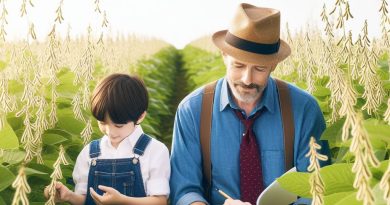Organic vs. Conventional: A Farmer’s View
Last Updated on March 1, 2024
Introduction
As a farmer, I believe it is crucial to examine the organic vs. conventional farming debate.
Understanding both approaches is vital for consumers and farmers alike.
Organic farming
Organic farming focuses on natural methods, using compost, green manure, and natural pest control.
These practices aim to promote soil health, biodiversity, and sustainable farming methods.
Organic farmers prioritize the use of organic materials and avoid synthetic pesticides and fertilizers.
Conventional farming
Conventional farming uses modern technology, synthetic fertilizers, and pesticides to maximize crop yields.
This approach involves genetically modified organisms (GMOs) and chemical inputs to control pests and improve productivity.
Conventional farmers strive to produce high quantities of food to meet the demands of a growing population.
The importance for consumers
Understanding the differences between organic and conventional farming allows consumers to make informed choices.
Organic farming provides consumers with a sense of environmental responsibility and supports sustainable practices.
Conventional farming offers an affordable and accessible food supply, addressing global hunger concerns.
The importance for farmers
Familiarity with both organic and conventional farming methods helps farmers adapt to evolving market demands.
Organic farming provides opportunities for niche markets and higher prices, appealing to environmentally conscious consumers.
Conventional farming enables large-scale production and technological advancements, ensuring food security.
Both organic and conventional farming approaches have their merits, highlighting the importance of understanding both sides.
By considering the needs of consumers and the challenges faced by farmers, we can work towards a more sustainable and productive agricultural industry.
Overview of Organic Farming
- Organic farming is a method that emphasizes the use of natural processes and materials.
- Main principles include promoting ecological balance, conserving biodiversity, and minimizing pollution.
- Organic-approved inputs, such as compost and natural pesticides, are used instead of synthetic chemicals.
- Compost, made from decomposed organic matter, provides important nutrients and improves soil quality.
- Natural pesticides derived from plants or minerals are used to control pests and diseases.
- Organic farmers focus on maintaining soil health by using practices like crop rotation and cover cropping.
- Soil fertility is enhanced through the use of organic matter, which improves water and nutrient retention.
- Biodiversity is essential in organic farming as it increases resilience to pests, diseases, and climate change.
- Promoting habitats for beneficial insects and wildlife helps create a balanced ecosystem on the farm.
The Use of Organic-Approved Inputs
- Organic farming strictly limits the use of synthetic fertilizers, pesticides, and genetically modified organisms (GMOs).
- Compost, made from plant and animal waste, is a vital organic-approved input for improving soil fertility.
- Compost adds beneficial microorganisms, organic matter, and essential nutrients to the soil.
- Natural pesticides, derived from sources like neem oil or garlic, are used for pest control.
- These pesticides are less harmful to humans, beneficial insects, and the environment compared to synthetic chemicals.
- Organic farmers also use biological control methods, such as introducing predatory insects, to manage pests.
The Focus on Soil Health and Biodiversity
- Organic farming recognizes the significance of maintaining and improving soil health for sustainable agriculture.
- Healthy soil is rich in organic matter, well-structured, and biologically active.
- Organic farmers avoid excessive tilling, which can disrupt soil structure and lead to erosion.
- Practices like cover cropping help prevent erosion, improve soil fertility, and suppress weeds.
- Crop rotation is another important technique used in organic farming to break pest and disease cycles.
- By diversifying crops, organic farmers reduce the risk of yield losses and improve overall farm resilience.
- Organic farming encourages the conservation of biodiversity by providing habitats for beneficial insects and wildlife.
- Hedgerows, wildflower borders, and ponds are examples of features that support biodiversity on organic farms.
In general, organic farming emphasizes the use of natural processes and materials to promote ecological balance, conserve biodiversity, and minimize pollution.
Organic-approved inputs like compost and natural pesticides are vital for maintaining soil health and managing pests.
The focus on soil health involves practices such as crop rotation and cover cropping, while biodiversity conservation creates a balanced ecosystem on organic farms.
By prioritizing these principles and techniques, organic farmers contribute to the sustainability and long-term health of our food system.
Advantages of Organic Farming
In the realm of agriculture, organic farming stands tall, offering a plethora of advantages over conventional methods.
By shunning synthetic pesticides and fertilizers, organic farming extends a welcoming hand to the environment.
Chemical use dwindles, preserving ecosystems vital for biodiversity.
Reduced reliance on chemicals nurtures soil health, fostering a thriving microbial community.
Organic practices safeguard water bodies, curbing pollution runoff from harmful agrochemicals.
Wildlife finds refuge in organic farms, free from the adverse effects of toxic substances.
The potential health benefits of organic produce due to lower pesticide residues
Health benefits bloom in organic produce, thanks to lower pesticide residues.
Consumers relish fruits and vegetables brimming with nutrients, untainted by synthetic additives.
With each bite, they savor the assurance of wholesome nourishment.
Organic farming practices can promote sustainable agriculture in the long term
Organic farming isn’t merely a trend; it’s a sustainable approach to agriculture.
Farmers become stewards of the land, embracing practices that nurture rather than deplete.
Crop rotation, composting, and natural pest control become the norm.
Long-term sustainability becomes the cornerstone of organic agriculture.
By eschewing monoculture, farmers mitigate the risk of pest outbreaks and crop failures.
Diversity flourishes, creating resilient ecosystems capable of weathering environmental challenges.
Soil fertility becomes a treasure to cherish, replenished through organic matter and natural processes.
Carbon sequestration becomes a silent ally in the fight against climate change.
With each harvest, organic farmers contribute to a healthier planet.
Communities surrounding organic farms breathe cleaner air, free from the noxious fumes of chemical pesticides.
Waterways flow crystal clear, supporting aquatic life and recreational activities.
The landscape transforms into a haven for both humans and wildlife.
Economic resilience blossoms within the realms of organic farming.
While initial transition costs may pose a challenge, the long-term benefits far outweigh the investment.
Organic premiums reward farmers for their dedication to sustainability and quality.
Consumers vote with their wallets, choosing organic for its superior taste and nutritional value.
They forge a connection with the land, understanding the importance of supporting sustainable practices.
Organic farming becomes more than a choice; it becomes a way of life.
In summary, the advantages of organic farming extend far beyond the boundaries of the farm.
They encompass environmental stewardship, human health, and long-term sustainability.
As we tread into the future, let us embrace organic agriculture as a beacon of hope for a better tomorrow.
Read: LA’s Urban Farm Revolution: A Local’s Story
Challenges of Organic Farming
In this section, we will explore the challenges that organic farming faces, including lower yields, increased labor requirements, difficulties in weed and pest management, and higher costs associated with organic certification and production.
Potential Limitations of Organic Farming
Organic farming, although beneficial for the environment and human health, often faces certain limitations.
Lower Yields
One significant challenge of organic farming is the potential for lower yields compared to conventional farming methods.
Organic farmers rely on natural fertilizers and pest control methods, which may not provide the same level of efficacy as synthetic alternatives.
Additionally, organic practices often require a longer time for soil to reach optimum fertility, resulting in slower plant growth and lower overall crop yield.
Increased Labor Requirements
Another challenge faced by organic farmers is the increased labor requirements associated with organic production.
Organic farmers typically rely on manual labor for tasks such as weed control, pest management, and soil preservation.
Unlike conventional farming, where synthetic herbicides and pesticides can be used for weed and pest control, organic farmers must invest more time and effort in these activities to ensure their crops remain free from harmful chemicals.
Difficulties in Weed and Pest Management
One of the most significant challenges for organic farmers is managing weeds and pests without the use of synthetic chemicals.
Weed Management
Organic farmers face difficulties in weed management due to the absence of synthetic herbicides.
They often resort to cultural practices such as hand weeding, crop rotation, and mulching to control weeds.
While these practices can be effective, they require a significant amount of manual labor and may not provide the same level of weed control as synthetic herbicides.
Pest Management
Similarly, organic farmers struggle with pest management without synthetic pesticides.
Instead, they implement techniques like biological control, habitat manipulation, and crop rotation to minimize pest damage.
However, these methods can be less reliable than chemical pesticides, resulting in potential yield losses and significant challenges in protecting crops from pests.
Higher Costs Associated with Organic Certification and Production
Another challenge faced by organic farmers is the higher costs associated with organic certification and production.
Organic Certification
In order to label their products as organic, farmers must undergo a rigorous certification process, which includes inspections, documentation, and compliance with strict regulations.
This certification process can be expensive and time-consuming, adding to the overall cost of organic farming.
Production Costs
Organic farming often requires additional investments in sustainable infrastructure, organic fertilizers, and pest control measures.
These higher production costs can result in increased prices for organic products, making them less accessible to some consumers.
While organic farming offers numerous benefits, it is not without its challenges.
Lower yields, increased labor requirements for weed and pest management, and higher costs associated with organic certification and production are all potential limitations that organic farmers face.
Despite these challenges, many farmers choose to embrace organic practices due to their positive impact on the environment, consumer demand for organic products, and long-term sustainability.
Read: From Concrete to Crops: Boston’s Urban Farms

Overview of Conventional Farming
Define conventional farming and its common practices, including the use of synthetic pesticides and fertilizers
Conventional farming, the mainstream approach, relies on synthetic inputs like pesticides and fertilizers for crop production.
These inputs aim to enhance yields by controlling pests and weeds and boosting soil fertility.
Synthetic pesticides are chemical substances designed to kill or repel pests that threaten crops.
Farmers often apply these pesticides preventatively or reactively to protect their crops from insect damage.
Similarly, synthetic fertilizers contain essential nutrients like nitrogen, phosphorus, and potassium, providing plants with the nutrients they need for growth.
These fertilizers are usually applied to replenish soil nutrients depleted by previous crops.
The role of technology and genetically modified organisms (GMOs) in conventional farming
Technology plays a pivotal role in conventional farming, revolutionizing agricultural practices.
Machinery such as tractors, harvesters, and irrigation systems streamline operations, increasing efficiency and productivity.
Genetically modified organisms (GMOs) are another hallmark of conventional farming.
These organisms are engineered in labs to possess desired traits, such as resistance to pests or tolerance to herbicides, enhancing crop resilience and yields.
GMOs have sparked debates regarding their safety and environmental impact, but proponents argue that they offer solutions to global food security challenges by improving crop performance and reducing reliance on chemical inputs.
The importance of conventional farming for meeting global food demands
Conventional farming’s significance in meeting global food demands cannot be overstated.
With the world population projected to reach 9 billion by 2050, conventional methods are vital for ensuring an adequate food supply.
By employing synthetic inputs, technology, and GMOs, conventional farming maximizes crop yields to feed an ever-growing population.
Without these methods, it would be challenging to produce sufficient food to sustain humanity’s needs.
Critics raise concerns about the environmental consequences of conventional farming, citing issues like soil degradation, water pollution, and loss of biodiversity.
However, proponents argue that modern agricultural practices aim to mitigate these impacts through sustainable farming techniques.
Despite these debates, conventional farming remains the dominant method globally, supplying the majority of the world’s food.
Its efficiency and scalability make it indispensable for meeting the demands of a burgeoning population.
In a nutshell, conventional farming represents the prevailing approach to agricultural production, utilizing synthetic inputs, technology, and GMOs to maximize yields.
While facing criticisms, its importance in addressing global food security challenges cannot be denied.
As technology advances, conventional farming continues to evolve, striving for sustainability and efficiency in feeding the world.
Read: Women in Overalls: Life on the Family Farm
Advantages of Conventional Farming
In the realm of agriculture, conventional farming stands tall, promising an array of advantages.
With its focus on efficiency and productivity, this method offers a host of benefits that cannot be overlooked.
The potential benefits of higher yields, increased productivity, and lower food costs
First and foremost, conventional farming boasts higher yields.
Through the strategic use of synthetic fertilizers and pesticides, it maximizes crop output, ensuring bountiful harvests year after year.
Moreover, increased productivity is a hallmark of conventional farming practices.
By employing modern machinery and techniques, farmers can cultivate larger areas of land in less time, optimizing their resources effectively.
The allure of lower food costs is undeniable.
Conventional farming’s ability to produce greater quantities of crops translates to more affordable prices for consumers, easing the burden on their wallets.
In a world grappling with food shortages, conventional farming emerges as a beacon of hope.
Its streamlined processes and intensive cultivation methods enable farmers to meet the escalating demand for food, thereby mitigating scarcity concerns.
Conventional farming practices can help address food shortages and feed a growing population
Furthermore, conventional farming plays a pivotal role in feeding a burgeoning global population.
With projections indicating a population surge in the coming decades, the need for abundant food supplies has never been more pressing.
The potential for innovative technologies to increase efficiency in conventional farming
In addressing this challenge, conventional farming shines.
By harnessing the power of advanced agricultural technologies, such as genetically modified organisms (GMOs) and precision farming, it empowers farmers to produce more food on limited land without compromising quality.
The potential for innovative technologies to revolutionize conventional farming is immense.
From automated machinery to data-driven analytics, these advancements hold the key to unlocking unprecedented levels of efficiency and sustainability.
By embracing these cutting-edge solutions, conventional farmers can optimize resource utilization, minimize waste, and enhance overall productivity.
In fact, the advantages of conventional farming are manifold and far-reaching.
From higher yields and increased productivity to lower food costs and innovative technologies, this method holds immense promise for addressing the pressing challenges of our time.
As we navigate an increasingly complex agricultural landscape, let us not overlook the contributions of conventional farming in shaping a more food-secure future for generations to come.
Read: Seattle’s Rainy Farms: An Urban Farmer’s Diary
Challenges of Conventional Farming
The potential environmental concerns associated with chemical usage and soil degradation
In conventional farming, one of the biggest challenges is the potential environmental concerns associated with chemical usage.
The use of pesticides, herbicides, and fertilizers can contaminate the soil and water sources.
This can lead to the degradation of the soil quality and contribute to the loss of biodiversity.
The excessive use of chemicals can also harm beneficial insects, birds, and other wildlife.
Additionally, conventional farming practices often rely heavily on fossil fuels for machinery and transportation.
This contributes to greenhouse gas emissions and accelerates climate change.
Address consumer health concerns regarding pesticide residues in conventional produce
Another concern for consumers is the presence of pesticide residues in conventional produce.
Many pesticides used in conventional farming have been linked to health issues and even cancer.
Some studies have shown that exposure to these residues can have negative effects, especially in children and pregnant women.
While regulatory bodies set limits for these residues, some argue that more research is needed to fully understand their long-term effects on human health.
Furthermore, conventional farming practices can lead to the depletion of natural resources.
Soil erosion, caused by tilling and monoculture cropping systems, can degrade soil quality.
This makes it more difficult for crops to absorb nutrients and can lead to increased chemical inputs.
Water resources are also at risk due to the excessive irrigation often used in conventional farming.
Efficient water management and conservation practices are crucial to reduce the strain on water sources.
The need for sustainable practices and responsible use of inputs in conventional farming
Considering these challenges, there is a growing need for sustainable practices and responsible use of inputs in conventional farming.
There is a shift towards integrated pest management, which involves using natural predators and biological controls to manage pests.
Crop rotation and cover cropping are also employed to improve soil health and reduce the need for synthetic fertilizers.
Additionally, precision farming techniques are being adopted to optimize the use of resources and minimize waste.
These practices not only benefit the environment but also improve the long-term viability and profitability of farms.
It is important for farmers to stay informed about the latest research and innovations in sustainable agriculture.
By implementing these practices, conventional farmers can reduce their impact on the environment and address consumer concerns.
Overall, while conventional farming has faced criticism for its potential environmental and health concerns, there are steps being taken towards a more sustainable future.
With the adoption of responsible practices, conventional farmers can continue to provide a safe and abundant food supply.
Delve into the Subject: Vertical Farming: A High-Rise Harvest
Considerations for Farmers
When it comes to choosing between organic and conventional farming, farmers have several factors they should consider:
Environmental Impact
- Evaluate the potential impact of each farming method on the environment and local ecosystem.
- Consider the use of synthetic pesticides and fertilizers in conventional farming.
- Assess the long-term sustainability of farming practices for future generations.
Soil Health and Nutrient Management
- Analyze the effect of organic farming on soil health, including soil structure and nutrient content.
- Consider the benefits of cover cropping and crop rotations in organic farming systems.
- Calculate the cost and effectiveness of conventional fertilizers in achieving optimal soil fertility.
Pest and Disease Management
- Evaluate the efficacy of organic pest control methods, such as crop diversity and biological controls.
- Assess the potential economic losses due to pests and diseases in both organic and conventional systems.
- Research the availability of organic-certified pesticides and their compatibility with specific crops.
Labor and Cost Considerations
- Estimate the labor requirements for both organic and conventional farming practices.
- Consider the cost of organic certification and compliance with organic standards.
- Weigh the potential market premiums for organic products against the higher production costs.
Market Demand and Consumer Preferences
- Research the current market demand for organic products in your region.
- Consider consumer preferences for pesticide-free, sustainable, and locally sourced produce.
- Evaluate the potential market opportunities and competitive advantages of organic farming.
Risk Management
- Assess the potential risks associated with organic farming, such as yield variability and weed control.
- Evaluate the availability of crop insurance and other risk mitigation strategies for organic farmers.
- Consider the resilience of your farm to potential weather events and climate change impacts.
In short, before making a decision between organic and conventional farming, farmers should take into account the environmental, economic, and market considerations discussed above.
It is crucial to evaluate their specific circumstances, resources, and long-term goals.
Ultimately, the choice should align with both their values and the demands of the market they serve.
Conclusion
In this blog post, the viewpoints of a farmer regarding organic vs. conventional farming have been extensively discussed.
The farmer shared valuable insights, highlighting the advantages and disadvantages of both methods.
It is vital to approach farming practices with a balanced and informed perspective.
While organic farming focuses on sustainability and avoiding synthetic inputs, conventional farming utilizes technology and synthetic inputs to increase productivity.
Readers are encouraged to support local farmers who work tirelessly to provide food to their communities.
By choosing food that aligns with their values and preferences, individuals can contribute to the sustainability of their local agricultural systems.
In closing, both organic and conventional farming have their merits and challenges.
Understanding the bigger picture and considering various factors are crucial for making informed choices about the food we consume.
By supporting local farmers and making conscious decisions, we can promote a healthier and more sustainable food system.


